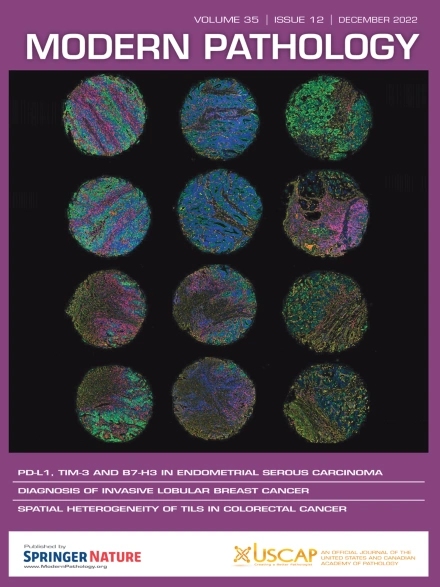传统和未分化黑色素瘤基因组对比研究
IF 7.1
1区 医学
Q1 PATHOLOGY
引用次数: 0
摘要
未分化黑色素瘤是指失去了传统黑色素瘤所有常见表型和免疫组化特征的黑色素瘤,它可能给诊断带来重大挑战。分子研究表明,未分化黑色素瘤中的一部分存在已知的黑色素瘤驱动基因改变,如 BRAF、NRAS 和 NF1,从而加深了我们对未分化黑色素瘤的了解。然而,描述可将未分化黑色素瘤与传统黑色素瘤区分开来的基因改变的数据还很少。在这项研究中,我们直接比较了未分化黑色素瘤与传统黑色素瘤的基因组图谱,包括14例未分化黑色素瘤(包括2例原发病例、2例皮肤复发病例和10例转移病例)和127例传统黑色素瘤(包括原发、复发和转移病例)。研究人员对 447 个癌症相关基因进行了靶向测序,包括突变和拷贝数改变(CNA)的鉴定。在未分化黑色素瘤中,NRAS是最常见的黑色素瘤驱动基因(8/14例,57%),但值得注意的是,只有一个未分化黑色素瘤携带NRAS Q61R突变。与常规黑色素瘤队列相比,未分化黑色素瘤在统计学上明显富含致病性活化RAC1突变(共6/14例,43%),包括P29S(4/6例)、P29L(1/6例)和D11E(1/6例)。这些发现不仅有助于深入了解未分化黑色素瘤的分子发病机制,而且还表明,RAS Q61R 免疫组化在诊断未分化黑色素瘤方面的作用可能有限。未分化黑色素瘤中反复出现的RAC1突变也值得注意,因为这些改变可能会导致丝裂原活化蛋白(MAP)激酶通路靶向治疗耐药。此外,在这组患者中发现的RAC1基因突变已被证明能促使黑色素细胞向间质细胞转变,从而为这些黑色素瘤的未分化表型提供了可能的解释。本文章由计算机程序翻译,如有差异,请以英文原文为准。
A Comparative Genomic Study of Conventional and Undifferentiated Melanoma
Undifferentiated melanoma, defined as melanoma that has lost all usual phenotypic and immunohistochemical characteristics of conventional melanoma, can pose significant diagnostic challenges. Molecular studies have advanced our understanding of undifferentiated melanoma by demonstrating that a subset of these tumors harbors known melanoma driver alterations in genes such as BRAF, NRAS, and NF1. However, there is a paucity of data describing genetic alterations that may distinguish undifferentiated melanoma from conventional melanoma. In this study, we directly compared the genomic profiles of undifferentiated melanoma to a cohort of conventional melanomas, including 14 undifferentiated melanoma cases (comprised of 2 primary cases, 2 cutaneous recurrences, and 10 metastases) and a cohort of 127 conventional melanomas including primary, recurrent, and metastatic cases. Targeted sequencing of 447 cancer-associated genes was performed, including identification of mutations and copy number alterations. NRAS was the most frequent melanoma driver in undifferentiated melanoma (8/14 cases, 57%), although notably, only 1 undifferentiated melanoma harbored an NRAS Q61R mutation. Compared with the conventional melanoma cohort, undifferentiated melanoma demonstrated statistically significant enrichment of pathogenic activating RAC1 mutations (6/14 total cases, 43%), including P29S (4/6 cases), P29L (1/6 cases), and D11E (1/6 cases). In addition to providing insight into the molecular pathogenesis of undifferentiated melanoma, these findings also suggest that RAS Q61R immunohistochemistry may have limited utility for its diagnosis. The presence of recurrent RAC1 mutations in undifferentiated melanoma is also notable as these alterations may contribute to mitogen-activated protein kinase pathway–targeted therapy resistance. Furthermore, the RAC1 alterations identified in this cohort have been shown to drive a melanocytic to mesenchymal switch in melanocytes, offering a possible explanation for the undifferentiated phenotype of these melanomas.
求助全文
通过发布文献求助,成功后即可免费获取论文全文。
去求助
来源期刊

Modern Pathology
医学-病理学
CiteScore
14.30
自引率
2.70%
发文量
174
审稿时长
18 days
期刊介绍:
Modern Pathology, an international journal under the ownership of The United States & Canadian Academy of Pathology (USCAP), serves as an authoritative platform for publishing top-tier clinical and translational research studies in pathology.
Original manuscripts are the primary focus of Modern Pathology, complemented by impactful editorials, reviews, and practice guidelines covering all facets of precision diagnostics in human pathology. The journal's scope includes advancements in molecular diagnostics and genomic classifications of diseases, breakthroughs in immune-oncology, computational science, applied bioinformatics, and digital pathology.
 求助内容:
求助内容: 应助结果提醒方式:
应助结果提醒方式:


